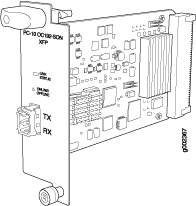|
Description
|
|
|
Hardware features
|
|
|
Software features
|
-
SONET/SDH framing
-
Link aggregation
-
Alarm and event counting and detection
-
Dual-router automatic protection switching (APS)
-
Multiprotocol Label Switching (MPLS) fast reroute
-
Encapsulations:
-
Circuit cross-connect (CCC)
-
Translational cross-connect (TCC)
-
Frame Relay
-
High-Level Data Link Control (HDLC)
-
Point-to-Point Protocol (PPP)
|
|
Cables and connectors
|
Tip:
You
can use the Hardware Compatibility
Tool to find information about the pluggable transceivers supported
on your Juniper Networks device.
Note:
To extend the life of the laser, when a PIC is not being
actively used with any valid links, take the PIC offline until you
are ready to establish a link to another device. For information about
taking a PIC offline, see the request chassis pic offline command in the CLI Explorer.
|
|
LEDs
|
One tricolor LED per port:
-
Off—Not enabled
-
Green—Online with no alarms or failures
-
Yellow—Online with alarms for remote failures
-
Red—Active with a local alarm; router has detected
a failure
|
|
Alarms, errors, and events
|
-
SONET alarms:
-
Alarm indication signal—line (AIS-L)
-
Alarm indication signal—path (AIS-P)
-
Bit error rate—signal degrade (BERR-SD)
-
Bit error rate—signal fail (BERR-SF)
-
Bit interleaved parity (BIP) error B1, B2, B3
-
Far-end bit error: remote error indication—line
(REI-L), far-end line coding violations (CV-LFE)
-
Far-end bit error: remote error indication—path
(REI-P), far-end path coding violations (CV-PFE)
-
Loss of frame (LOF)
-
Loss of pointer (LOP-P)
-
Loss of signal (LOS)
-
Payload label mismatch (PLM-P)
-
Payload unequipped (unequipped STS at path level) (UNEQ-P)
-
Remote defect indication—line (RDI-L)
-
Remote defect indication—path (RDI-P)
-
SDH alarms:
-
Administrative unit alarm indication signal (AU-AIS)
-
Bit error rate signal degrade (BERR-SD)
-
Bit error rate signal fail (BERR-SF)
-
Bit interleaved parity (BIP) error B1, B2, B3
-
Higher order path—payload label mismatch (HP-PLM)
-
Higher order path—loss of pointer (HP-LOP)
-
Higher order path—remote defect indication (HP-RDI)
-
Higher order path—unequipped (HP-UNEQ)
-
Loss of frame (LOF)
-
Loss of signal (LOS)
-
Multiplex section—alarm indication signal (MS-AIS)
-
Multiplex section—remote defect indication (MS-RDI)
-
Multiplex section—remote error indication (MS-REI)
-
Error detection:
-
Errored seconds (ES-S, ES-L, ES-P)
-
Far-end errored seconds (ES-LFE, ES-PFE)
-
Far-end severely errored seconds (SES-LFE, SES-PFE)
-
Far-end unavailable seconds (UAS-LFE, UAS-PFE)
-
Severely errored framing (SEF)
-
Severely errored framing seconds (SEFS-S)
-
Severely errored seconds (SES-S, SES-L, SES-P)
-
Unavailable seconds (UAS-L, UAS-P)
|

